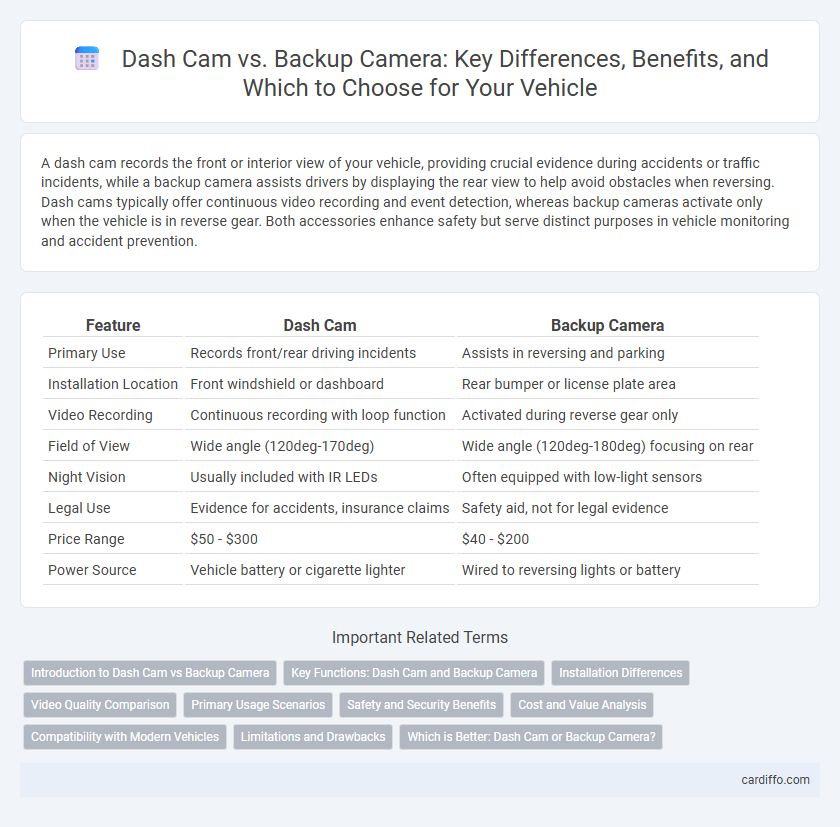A dash cam records the front or interior view of your vehicle, providing crucial evidence during accidents or traffic incidents, while a backup camera assists drivers by displaying the rear view to help avoid obstacles when reversing. Dash cams typically offer continuous video recording and event detection, whereas backup cameras activate only when the vehicle is in reverse gear. Both accessories enhance safety but serve distinct purposes in vehicle monitoring and accident prevention.
Table of Comparison
| Feature | Dash Cam | Backup Camera |
|---|---|---|
| Primary Use | Records front/rear driving incidents | Assists in reversing and parking |
| Installation Location | Front windshield or dashboard | Rear bumper or license plate area |
| Video Recording | Continuous recording with loop function | Activated during reverse gear only |
| Field of View | Wide angle (120deg-170deg) | Wide angle (120deg-180deg) focusing on rear |
| Night Vision | Usually included with IR LEDs | Often equipped with low-light sensors |
| Legal Use | Evidence for accidents, insurance claims | Safety aid, not for legal evidence |
| Price Range | $50 - $300 | $40 - $200 |
| Power Source | Vehicle battery or cigarette lighter | Wired to reversing lights or battery |
Introduction to Dash Cam vs Backup Camera
Dash cams and backup cameras serve distinct functions for vehicle safety and security, with dash cams continuously recording driving footage to provide evidence in accidents and deter theft, while backup cameras assist drivers in viewing blind spots behind the vehicle during reversing. Both accessories enhance driving awareness but target different aspects: dash cams focus on external surroundings during travel, and backup cameras primarily improve rear visibility to prevent collisions. Choosing between them depends on specific needs such as incident documentation or parking assistance.
Key Functions: Dash Cam and Backup Camera
Dash cams continuously record front or interior views to provide real-time evidence during driving incidents, enhancing driver security and accountability. Backup cameras offer real-time rear visibility to assist with parking and reversing maneuvers, reducing blind spots and the risk of collisions. Both accessories improve vehicle safety but serve distinct functions tailored to forward driving surveillance and rear obstacle detection.
Installation Differences
Dash cams typically install on the windshield using adhesive mounts or suction cups, requiring access to a power source such as the cigarette lighter or hardwiring to the vehicle's fuse box. Backup cameras are usually mounted on the rear license plate area or bumper, necessitating routing cables through the vehicle's body to connect with the display unit inside, often integrated with the infotainment system. Installation complexity for backup cameras tends to be higher due to wiring for video transmission and integration with reverse gear signals.
Video Quality Comparison
Dash cams typically offer higher video resolution and frame rates, ensuring clearer footage ideal for capturing events on the road. Backup cameras prioritize wide-angle views and night vision capabilities to improve safety during parking but may have lower resolution compared to dash cams. Both devices use HD or Full HD video standards, but dash cams often feature enhanced image stabilization and dynamic range for better video quality in varying light conditions.
Primary Usage Scenarios
Dash cams primarily capture real-time video footage of the road ahead to provide evidence during accidents or traffic incidents, enhancing driver safety and insurance claims. Backup cameras are designed to assist with reversing and parking by giving drivers a clear view of obstacles behind the vehicle, reducing blind spots and preventing collisions. Both accessories are crucial for vehicle safety but serve distinct purposes: dash cams for forward-facing surveillance and backup cameras for rear visibility assistance.
Safety and Security Benefits
Dash cams provide continuous recording of driving events, offering crucial evidence in case of accidents or disputes, thereby enhancing road safety and legal protection. Backup cameras improve rear visibility, reducing blind spots and preventing collisions with obstacles or pedestrians during reversing maneuvers. Together, these accessories significantly increase vehicle security by promoting safer driving practices and protecting against theft or damage.
Cost and Value Analysis
Dash cams typically range from $50 to $200, offering continuous recording and enhanced security features that justify their cost for vigilant drivers. Backup cameras generally cost between $70 and $250, providing critical assistance in preventing accidents and improving rear visibility, thus adding substantial safety value. While dash cams offer ongoing evidence capture, backup cameras deliver direct safety benefits, making cost-effectiveness dependent on individual priorities for security or accident prevention.
Compatibility with Modern Vehicles
Dash cams and backup cameras differ significantly in compatibility with modern vehicles, as dash cams are generally universal and can be installed in almost any car with a 12V power outlet. Backup cameras often require integration with the vehicle's existing display system and may depend on manufacturer-specific wiring and software protocols, impacting ease of installation. Many modern vehicles come pre-equipped with factory-installed backup cameras optimized for their infotainment systems, making aftermarket compatibility a crucial consideration.
Limitations and Drawbacks
Dash cams often suffer from limited rear visibility and can be obstructed by vehicle design, reducing their effectiveness compared to backup cameras. Backup cameras, while providing a clear rear view for parking and reversing, typically lack continuous recording features and may fail to capture incidents occurring away from the rear. Both accessories can experience reduced performance in low light or adverse weather conditions, highlighting the importance of choosing the right camera based on specific needs and installation constraints.
Which is Better: Dash Cam or Backup Camera?
Dash cams offer comprehensive front and rear road surveillance, capturing real-time footage to provide evidence during accidents or traffic disputes. Backup cameras specialize in enhancing rear visibility to prevent collisions while reversing, significantly improving parking safety. For all-around vehicle security and incident recording, dash cams are better, whereas backup cameras excel in aiding safe maneuvering in tight spaces.
Dash Cam vs Backup Camera Infographic

 cardiffo.com
cardiffo.com